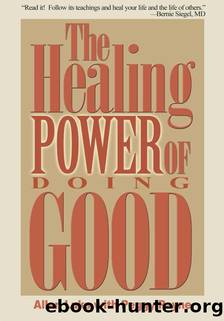The Healing Power of Doing Good by Unknown

Author:Unknown
Language: eng
Format: epub
Publisher: iUniverse
Published: 2001-04-28T16:00:00+00:00
A SPARK THAT CATCHES FIRE
Though religion is by no means crucial to the fostering of altruism—in fact only 22 percent of the volunteers surveyed in a 1988 Gallup Poll cited religion as their motivation for volunteering—a person who feels in some way affiliated with an organized religion is likelier than others to be a volunteer. A recent survey found that slightly more than half the people who belong to congregations were doing some helping. Of nonmembers, only one-third were volunteers.17
At its best, religion can inspire, promote, and even institutionalize altruism. The story of a very remarkable small town in France shows how the influence of a religious belief can transform a community. The story of Le Chambon has been told again and again, in movies such as Pierre Sauvage’s Weapons of the Spirit and books such as The Courage to Care, based on a film of the same title, but it is a story that is worth many recountings.
Le Chambon-sur-Lignon sits on a high plateau surrounded by higher mountains in the south-central part of France. It will be remembered for what happened there during the German occupation of France. Each of the five thousand people of this town refused to cooperate with the Nazis and the Vichy government. They not only refused to identify their resident Jews, but they turned the town into a haven for Jewish children and families from elsewhere. Not one refugee was ever turned in. Instead, five thousand Jews were rescued by this community, a number equal to the total population of the town.
A Protestant minister and his wife, André and Magda Trocmé, were at the center of what happened in Le Chambon. In the book The Courage to Care, Magda Trocmé tells how it began. “A poor woman came to my house one night, and she asked to come in. She said immediately that she was a German Jew, that she was running away, that she was hiding, that she wanted to have shelter. She thought that at the minister’s house she would perhaps find someone who could understand her. And I said, ‘Come in.’ And so it started. I did not know that it would be dangerous. Nobody thought of that.”
Magda Trocmé’s husband was a pacifist. From the pulpit of the church he preached, even on the day after armistice with Nazi Germany, that one’s responsibility was to resist violence with the weapons of the spirit. When he himself volunteered to go to a camp to take care of Jewish children, he was told that there were already people to do that. What was needed instead was a place to hide Jews. “Is your village prepared to do that?” he was asked.
Le Chambon-sur-Lignon did exactly that. The matter was presented to the council of the church, and within minutes they had agreed.
So, in Le Chambon, Jewish children went to school with Gentiles. They played together, sometimes with a pig that they called Adolf. Jewish children slept in the barns and stables of farms all around the town.
Download
This site does not store any files on its server. We only index and link to content provided by other sites. Please contact the content providers to delete copyright contents if any and email us, we'll remove relevant links or contents immediately.
Adulting by Kelly Williams Brown(4464)
Drawing Cutting Edge Anatomy by Christopher Hart(3437)
Figure Drawing for Artists by Steve Huston(3360)
Draw Your Day by Samantha Dion Baker(3256)
Drawing Shortcuts: Developing Quick Drawing Skills Using Today's Technology by Leggitt Jim(2975)
Make Comics Like the Pros by Greg Pak(2835)
Rapid Viz: A New Method for the Rapid Visualization of Ideas by Kurt Hanks & Larry Belliston(2813)
0041152001443424520 .pdf by Unknown(2771)
How Proust Can Change Your Life by Alain De Botton(2726)
Draw to Win: A Crash Course on How to Lead, Sell, and Innovate With Your Visual Mind by Dan Roam(2717)
How The Mind Works by Steven Pinker(2714)
Day by Elie Wiesel(2704)
Draw-A-Saurus by James Silvani(2633)
Tattoo Art by Doralba Picerno(2582)
Modern Cartooning by Christopher Hart(2537)
Learn Drawing Quickly by Sharon Finmark(2508)
Poses for Artists Volume 2 - Standing Poses: An essential reference for figure drawing and the human form. (Inspiring Art and Artists) by Justin Martin(2503)
Drawing and Painting Birds by Tim Wootton(2420)
Poses for Artists - Dynamic & Sitting: An essential reference for figure drawing and the human form (Inspiring Art and Artists Book 1) by Justin R Martin(2416)
